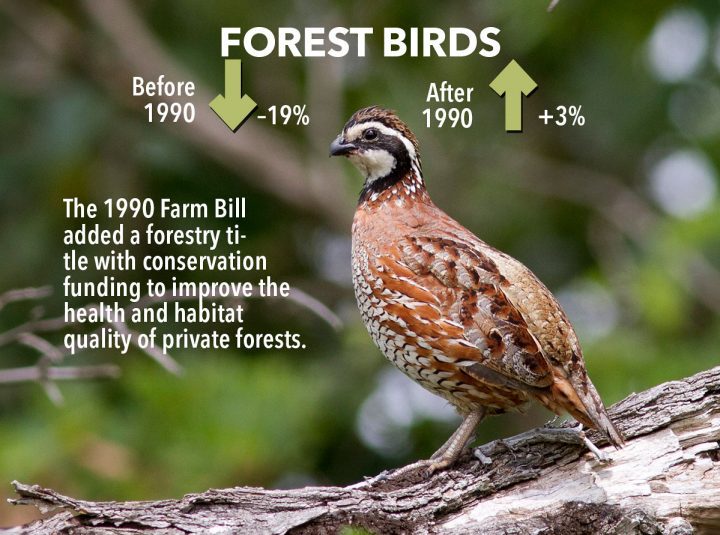Provisions in the Newly Signed Farm Bill Will Help Birds Into 2023
By Gustave Axelson
December 20, 2018

Today President Trump signed off on an update to the Farm Bill that passed Congress last week, and it looks like a good bill for birds.
In addition to setting federal agriculture policy for commodities like corn and soybeans and lots of other things from food stamps to farmers markets, the Farm Bill is also the largest source of funding for habitat conservation on private lands.
According to the 2017 State of the Birds report, the Farm Bill directly supports habitat for more than 100 bird species through billions of dollars of federal conservation funding. Farm Bill programs have helped spark waterfowl recoveries and growing local populations of Henslow’s Sparrows, and they’re the best hope to resuscitate declining species in farm country such as meadowlarks and bobwhite quail.
Conservationists were concerned about preliminary drafts of this most-recent Farm Bill legislation, namely proposals to gut conservation funding even beyond levels in the 2014 Farm Bill, which slashed conservation funding by $4 billion. But the 2018 Farm Bill at least mostly holds the line on conservation funding and preserves, or even expands, some of the most important conservation programs. Bird conservation groups are giving the new Farm Bill a thumbs up (or maybe more appropriately a wings up).


Each time the Farm Bill has introduced a conservation program (dots), bird populations have leveled out or rebounded. See following slides for more details about each group. 

Northern Pintails by Kevin McGowan. 

Northern Bobwhite by Linda Chittum/Macaulay Library. 

Henslow’s Sparrow by Jeff Timmons/Macaulay Library.
Here are the reviews so far:
- Cornell Lab of Ornithology—”The Farm Bill stands as a model for how bipartisan action can result in a win-win for people and the environment,” said Amanda Rodewald, the Cornell Lab’s director of conservation science. “The Bill not only supports the livelihoods of farmers, ranchers, and forest owners at a time when they face growing social, economic, and environmental pressures, but it also advances important efforts to restore degraded land, protect critical ecosystem services, and conserve biodiversity.”
- Audubon—“This Farm Bill is a huge win for birds and it gives us real tools to work together on clean water and places birds need while increasing productivity for farmers and ranchers across the country,” said David O’Neill, Audubon chief conservation officer. Audubon specifically applauded the boosts to wildlife funding in the Farm Bill’s Environmental Quality Incentives Program (which provides money for Audubon’s Conservation Ranching program) and to the Regional Conservation Partnership Program that allowed Audubon to partner with California dairy farmers on projects to protect nesting state-endangered Tricolored Blackbirds.
- Ducks Unlimited—“By providing full funding for the conservation title, Congress ensures these voluntary, incentive-based conservation programs will continue to create opportunities to work with farmers, ranchers, and landowners across the country,” said Ducks Unlimited CEO Dale Hall. The group praised increased funding and improvements to the program that operates Wetland Reserve Easements and the boost in enrolled acreage for the Conservation Reserve Program (cap raised to 27 million acres), which compensates farmers for not plowing up and even restoring wildlife habitat on their private lands.
- American Bird Conservancy—“This Farm Bill marks a victory for birds and the conservation work of farmers and landowners,” said Steve Holmer, ABC vice president of policy. “The final agreement also dropped numerous harmful provisions affecting federal forests, endangered species, and dangerous pesticides that kill millions of birds each year.” The conservancy was especially pleased with Regional Conservation Partnership Program boosts, which it said support conservation programs on private lands for Golden-winged and Cerulean Warblers.
This Farm Bill is good until 2023, at which point the debates and policy-making will resume for another reauthorization. But for now, conservationists will be focused on making the most of these program to grow more birds among the corn and soybeans in farm country.


All About Birds is a free resource
Available for everyone,
funded by donors like you


